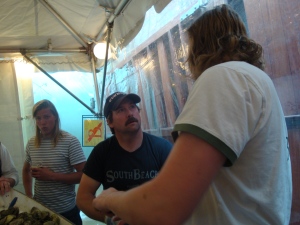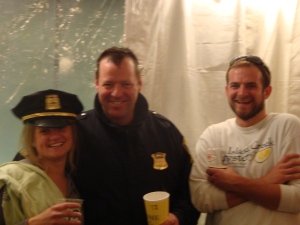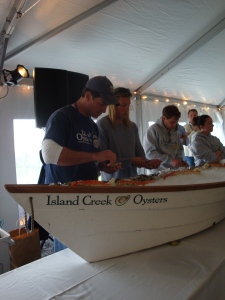 There are far too many fun stories to tell about this past weekend. Not sure this little blog will do it all justice. But here goes.
There are far too many fun stories to tell about this past weekend. Not sure this little blog will do it all justice. But here goes.
Most of the farm packed up early last week to hit Nantucket for the 2009 Wine Festival. On Friday, Will, Berg & I hopped a flight from Hyannis to the island and arrived just in time for a seminar hosted by Skip and Shore at the White Elephant. They were joined by Sarah Leah Chase, a cookbook author, Jamie Hamlin, a TV personality, as well as Jim Clendenen of Au Bon Climat wines. A group of us stood behind the raw bar shucking as Skip told the seated crowd the story of Island Creek. Sarah paired our oysters with a black pepper mignonette to start and later served them quite simply with grilled sausage. The sausage dish was a hit, as was the roasted bone marrow dish that followed it (no oysters but a fantastic pea shoot salad and a few dabs of Martha's Vineyard sea salt from).
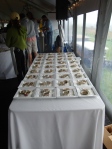
Jim had several fantastic things to say about our oysters which was a huge endorsement for us -- he called them "a delicious example of East Coast oysters." And we were absolutely enamored with his wines, especially the Hildegard and the Nuits-Blanches au Bouge. Really tasty juice.
Afterward, we packed up and got checked in to a few rooms at the Cottages (conveniently located above Provisions, the sandwich shop run by our friends Amanda Lydon and Gabriel Frasca who also run the Straight Wharf Restaurant) before turning thoughts towards dinner. Skip lead the charge to the Boarding House, owned by close friends of Island Creek, Seth & Angela Raynor. Somehow, after a trip into the kitchen, he was able to snag a table for all ten of us up in the Pearl's private dining room -- which was exactly the color of Pepto. The guys were unfazed so we sat down to a huge table and started an epically long (and hysterical), family style meal with a few cocktails and a magnum of Ridge Zinfandel. Skip took charge of ordering and out came a parade of amazing food: dumplings, soft shell crab, lettuce wraps, 60-second steak, wok fried lobster, black cod...it was never ending. Berg and I hoarded a few dishes at our end of the table just so we could lick the plates.
After dinner, we eventually found our way to The Chicken Box where the phenomenal U2 cover band, Joshua Tree, rocked straight until closing time. There were after parties, beers on the roof, and eventually, we all made it home safely to bed.
Saturday was an early one but we managed to get to the Nantucket Yacht Club in time for our 11 a.m. set up. We arrived to the tents and found our boat already in place (thanks to Shore and a few others) on the back lawn, right in front of the water under a powder blue sky. Picture perfect spot.
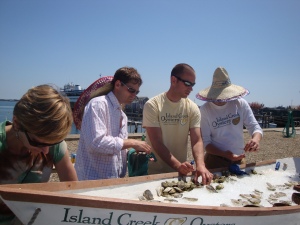
Seth and Angela and restaurant team were set up to grill Island Creeks with an ancho chilli butter and also created four toppings for us: straight mignonette (from the Boarding House), Thai lime dipping (the Pearl), tomatillo salsa, and regular salsa (their new ceviche bar and Peruvian restaurant, Corazon del Mar -- opening in a week or two). The Thai lime dipping was an unbe-lievable combo of garlic, cilantro, lime, Thai chillies, sugar, and fish sauce. By the end of the weekend, we were calling it Green Love. Just addictive stuff. We shucked for both the mid-day and afternoon sessions under pretty gorgeous weather which took a turn towards cloudy gray at the end. We kept at it and by the end of the day, had run out of about 5,000 oysters for the weekend. (But one quick phone call home and we had 25 more bags sent to us on the ferry -- thank you, Lisa). We also had an incredible crew of fans stop by the float -- many of whom wanted to buy the t-shirts off our back and wish us well. Jim Clendenen came by to pour wines with us for the afternoon session; we made friends with a huge oyster fan named Ted from Kentucky; my pals Alex Hall and Mike Blanding stayed the day; and Marlo Fogelman (Marlo Marketing Communications), Glen Kelley, and Janice O'Leary (from Boston Common magazine) swung by as well.
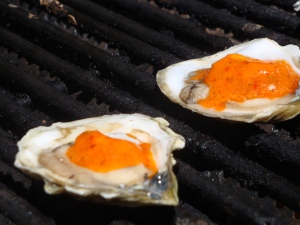
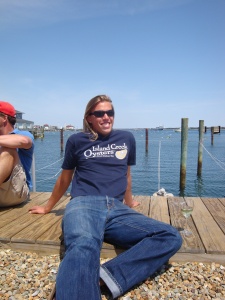
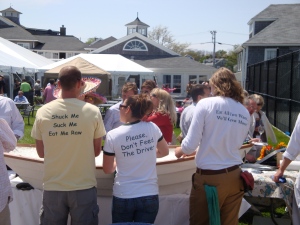
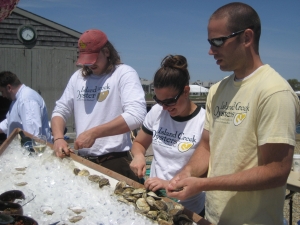
We managed to escape with a few farmers' tans and plenty of extra bottles of wine in us. A quick nap later and it was dinnertime once again. This time, we hit American Seasons, owned by Orla and Michael LaScola. This was a more intimate dinner (literally since two tables held all 8 men and myself) but we managed not to disturb too many other diners. We split two more magnums of Zinfandel (this one was called The Prisoner and at 15.2% alcohol, did most of us in) and ate another wonderful collection of dishes. My braised pork shank could have fed an army (well, ok, just myself and Berg... CJ gnawed at the bone) while the meatloaf "sandwich" topped with foie gras won for hands-down flavor.
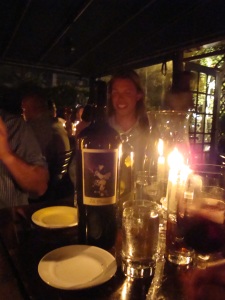
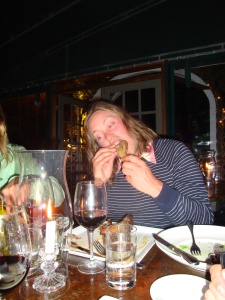
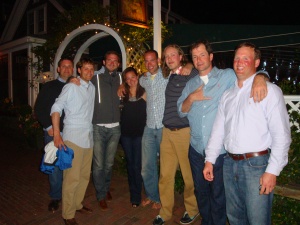
Again, our night turned a little rowdy and we found our way over to the Straight Wharf for a late-night dance party. The videos are priceless, but alas, too damaging to share.
Sunday, we found ourselves up and at 'em for the final day of Wine Fest and a rainy, foggy morning. The weather had us stuck indoors and without a grill at the Yacht Club but we made the most of it and kept things light with a few Mexican wrestling masks to entertain the oyster fans.
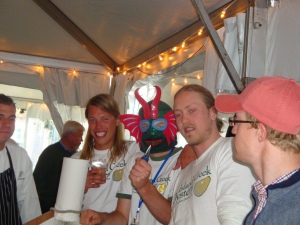
More wine and a pitcher of sangria appeared on our raw bar but once again, we escaped alive and finished the second session at 2 p.m. at which point Shore & CJ walked the raw bar boat through the streets of Nantucket and over to the Boarding House (in case you're wondering, the boat was hand-made by by a Duxbury local and yes, it's heavy).
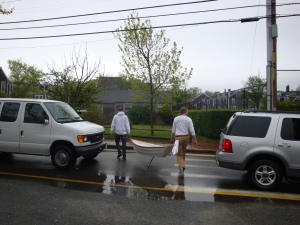
Once the raw bar and grill were re-set-up on the Boarding House patio we shucked for the Festival wind-down party. More of those fantastic sauces, more shucking, and more wrestling masks were in order. By the end, Skip looked as tired as we all felt and just kept saying, "The tide is going out on this one." One final meal at the Boarding House bar turned up a tasty plate of gnocchi, amazing French fries, a crispy, thin crust pizzetta with roasted grapes and arugula, and yes, a few more cocktails.
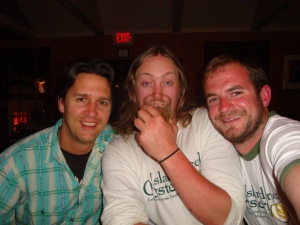
After we ate, Angela walked me over to Corazon del Mar, the couple's newest restaurant set to open in a few weeks. The concept is a Peruvian spot and ceviche bar and the aesthetic is gorgeous: think Mexican Gothic and romance. Really beautiful, two-story place.
One more night out meant one more stop at the Straight Wharf (with a pit stop at Captain Tobey's) and a round of shots for everyone at the bar. I finally got to catch up with Gabriel Frasca (who requested a few late-night oysters) before we shut down the bar and all stumbled home. It was one long finale to end a sweeping weekend of fun.
Of course, the 8 a.m. flight home wasn't nearly as idyllic but we still put in a pretty full day of work yesterday. And now... we catch up on sleep and officially say hello to summer.
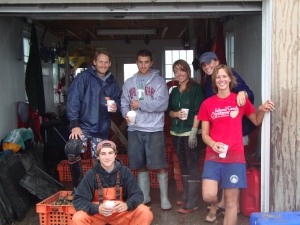
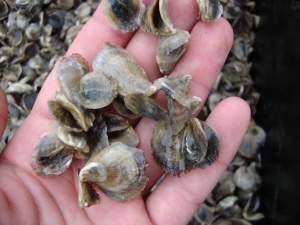 These 1/2" oysters are now going out to the river on a daily basis. The oysters we're planting are about twice this size. The color on the shells has faded from wine/amber/purple to the gray-ish green you find on full grown oysters. Still, they're beautiful to look at when they're this size. Imperfectly shaped but with the smoothness and curve of a fingernail. And they're sharp as hell. I've got a hand full of slivers from handling them this week.
These 1/2" oysters are now going out to the river on a daily basis. The oysters we're planting are about twice this size. The color on the shells has faded from wine/amber/purple to the gray-ish green you find on full grown oysters. Still, they're beautiful to look at when they're this size. Imperfectly shaped but with the smoothness and curve of a fingernail. And they're sharp as hell. I've got a hand full of slivers from handling them this week. 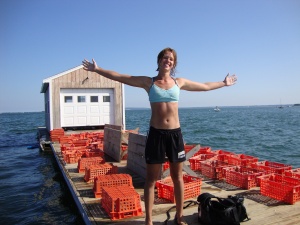 This was Eva's last week on the farm, sadly. One by one they go. We sent her off with a mini float party on Friday afternoon which ended with us creating crate city to keep the seagulls away. They've recently discovered that the roof on our house and the float itself are excellent spots to hang out -- they toss clams down onto the deck to crack them open and then crap all over the place. Not a pleasant sight first thing in the morning. But Skip installed a tiny device that simulates a seagull distress signal and keeps other gulls away. Apparently it works because the guys got to the float yesterday and found it free of poop. (Side note: If I'd known how much poop is involved in the world of oyster farming, I may not have asked for this job. At least I've gotten used to it.)
This was Eva's last week on the farm, sadly. One by one they go. We sent her off with a mini float party on Friday afternoon which ended with us creating crate city to keep the seagulls away. They've recently discovered that the roof on our house and the float itself are excellent spots to hang out -- they toss clams down onto the deck to crack them open and then crap all over the place. Not a pleasant sight first thing in the morning. But Skip installed a tiny device that simulates a seagull distress signal and keeps other gulls away. Apparently it works because the guys got to the float yesterday and found it free of poop. (Side note: If I'd known how much poop is involved in the world of oyster farming, I may not have asked for this job. At least I've gotten used to it.) 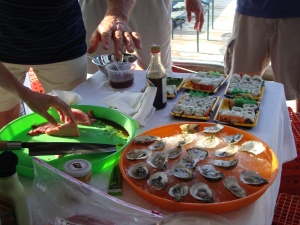
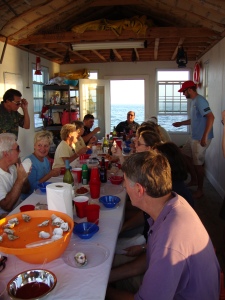

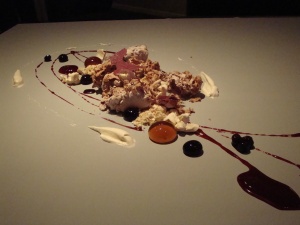
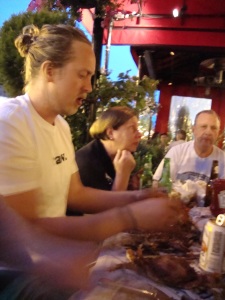
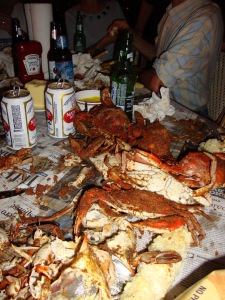
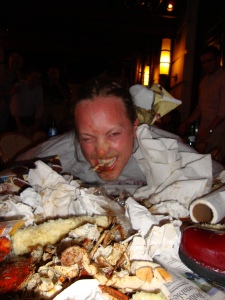
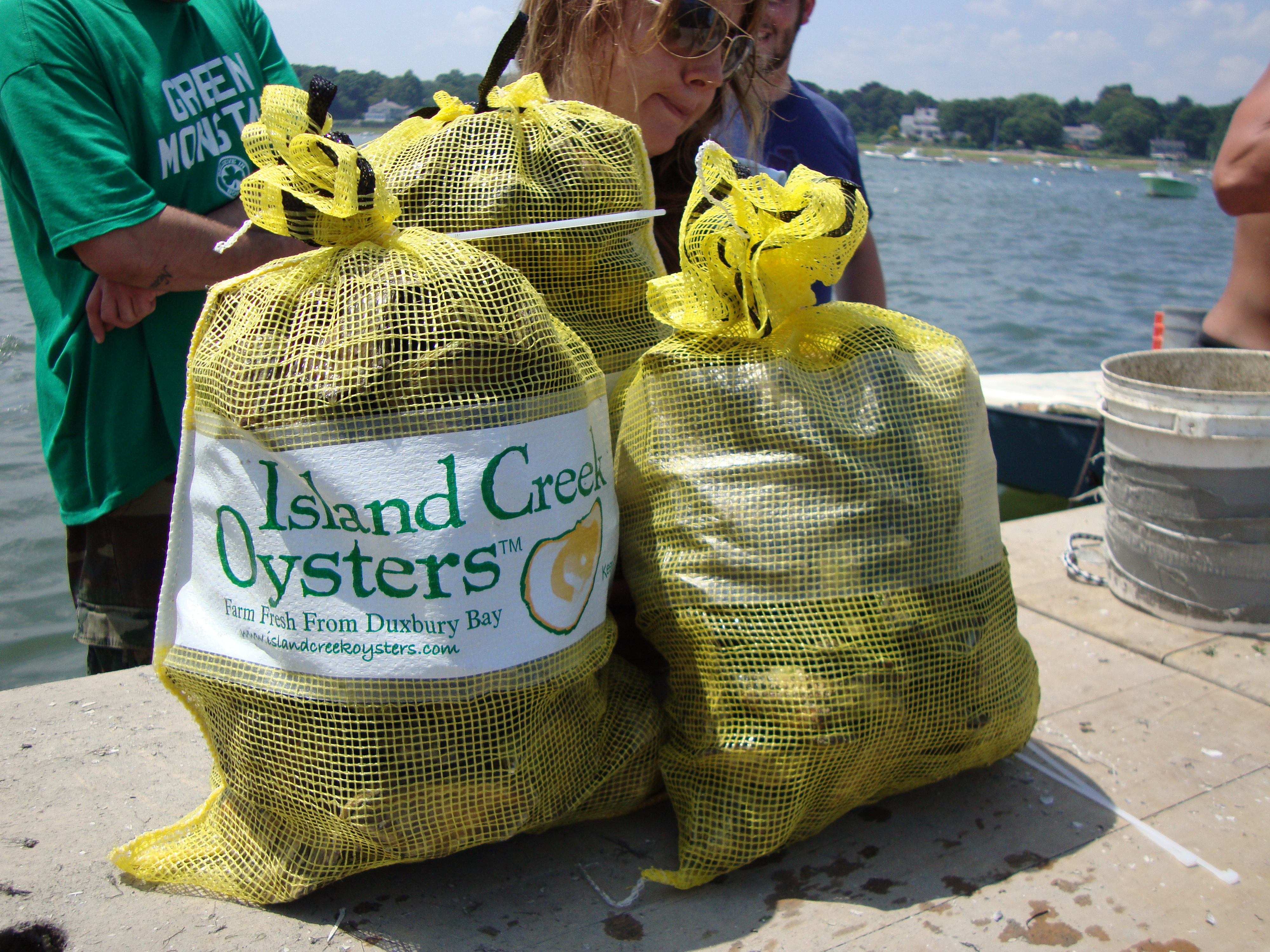 One of the main reasons I was drawn to Island Creek (aside from the oysters, of course), was the way in which the farm established relationships with chefs. Almost every Boston chef I can name knows of (and favors) Island Creek oysters. But more importantly, they all know Skip and "the guys from Island Creek." Skip and Shore have clearly worked hard to make theirs a well-known brand. But they've also opened the door and welcomed any chef that wants to come down to the water and check things out. While this isn't a new concept (chefs have probably visited farms and had relationships with their purveyors since restaurants were created), I knew early on that there was a takeaway with ICO that most chefs couldn't get anywhere else. Being on the water and going out to the lease can make people a little awe struck. There's a mystery behind growing oysters. Sure, it's scientific and methodical but oysters themselves aren't easy creatures to know. On top of which, the farm has an aura to it. The people there happen to love their lives and the place where they live. And sure it involves hard work, but it all takes place in the middle of a breathtaking bay.
One of the main reasons I was drawn to Island Creek (aside from the oysters, of course), was the way in which the farm established relationships with chefs. Almost every Boston chef I can name knows of (and favors) Island Creek oysters. But more importantly, they all know Skip and "the guys from Island Creek." Skip and Shore have clearly worked hard to make theirs a well-known brand. But they've also opened the door and welcomed any chef that wants to come down to the water and check things out. While this isn't a new concept (chefs have probably visited farms and had relationships with their purveyors since restaurants were created), I knew early on that there was a takeaway with ICO that most chefs couldn't get anywhere else. Being on the water and going out to the lease can make people a little awe struck. There's a mystery behind growing oysters. Sure, it's scientific and methodical but oysters themselves aren't easy creatures to know. On top of which, the farm has an aura to it. The people there happen to love their lives and the place where they live. And sure it involves hard work, but it all takes place in the middle of a breathtaking bay. 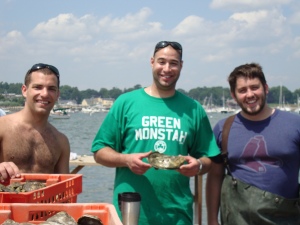
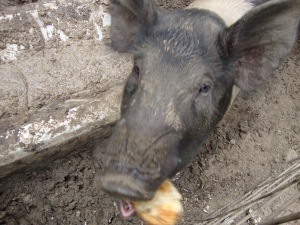
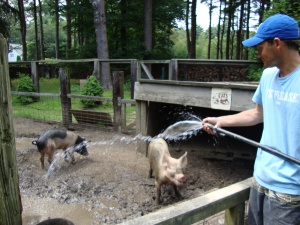
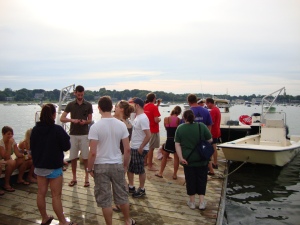
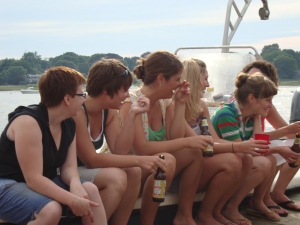
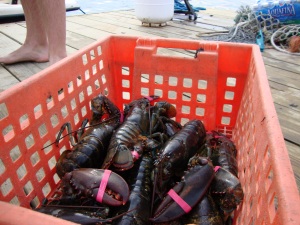
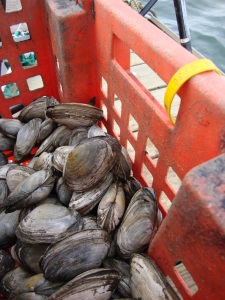
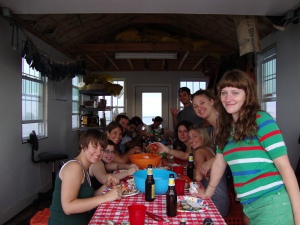

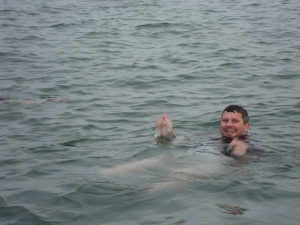
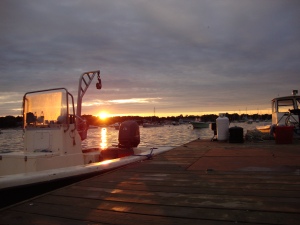
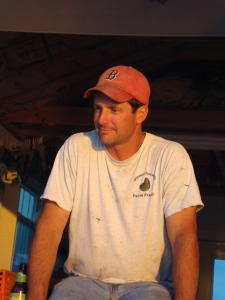
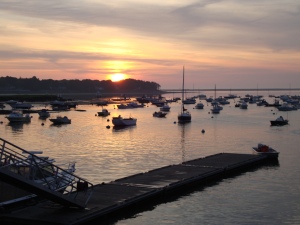
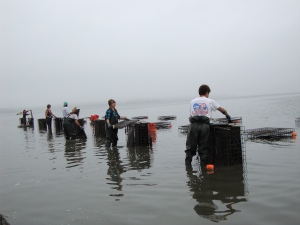
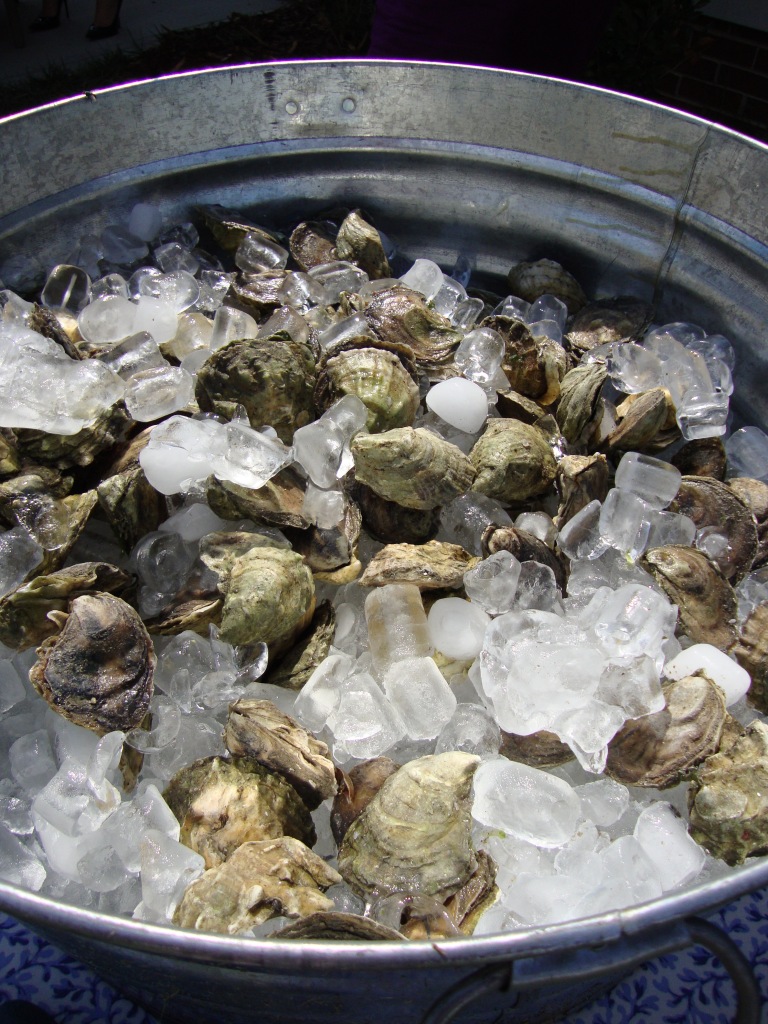
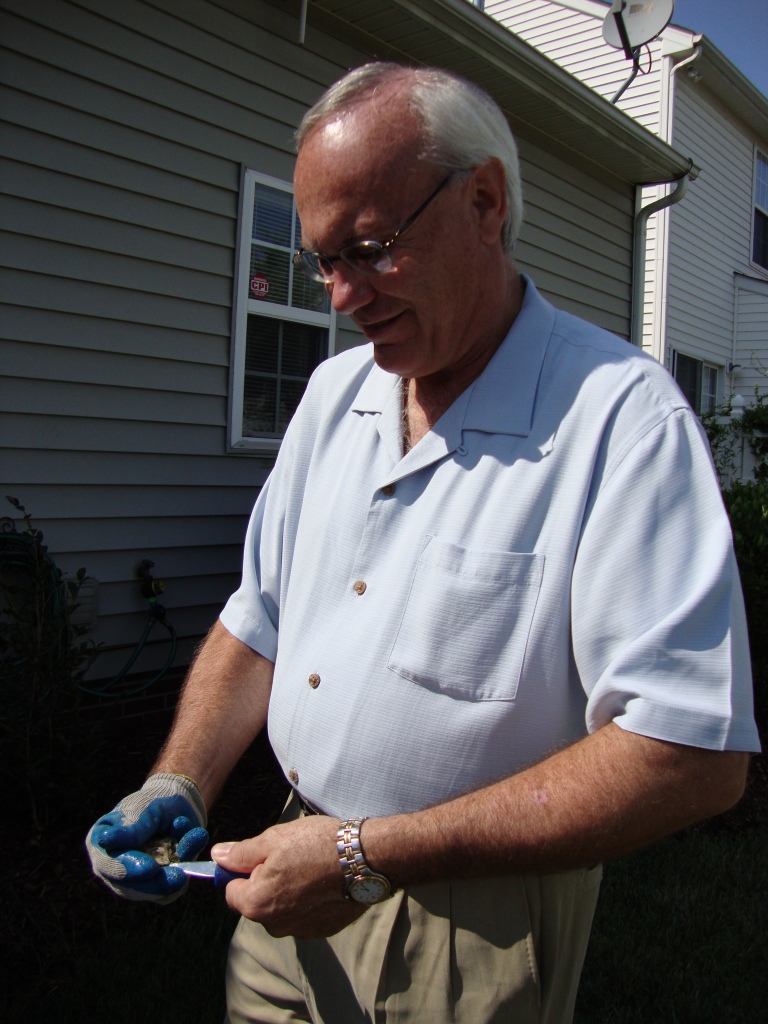
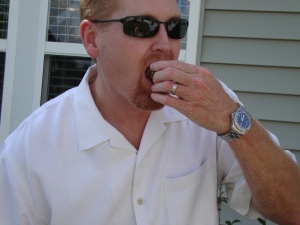
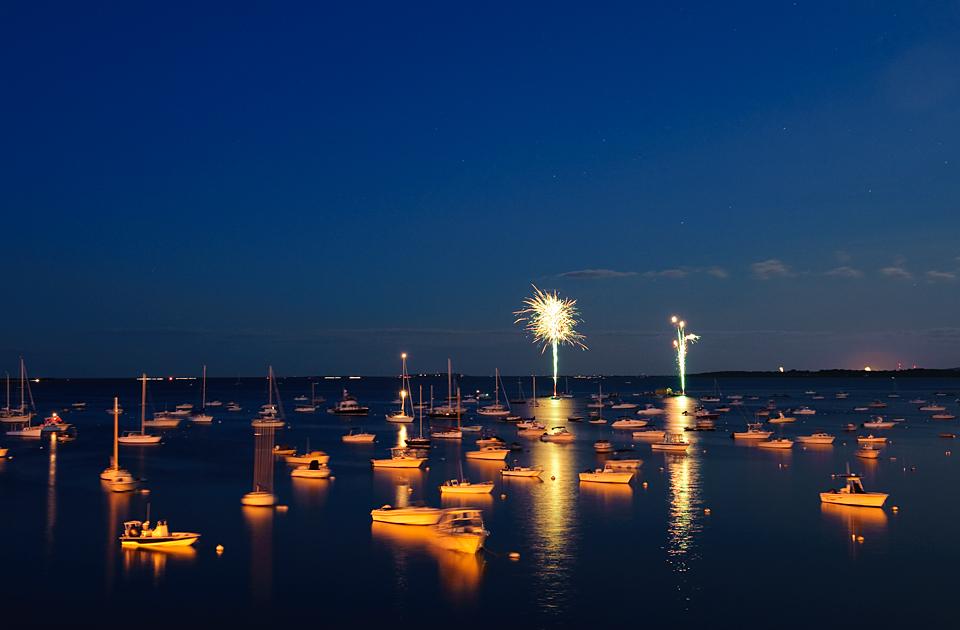
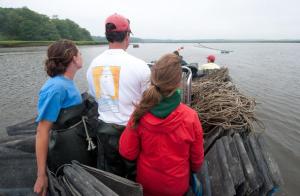
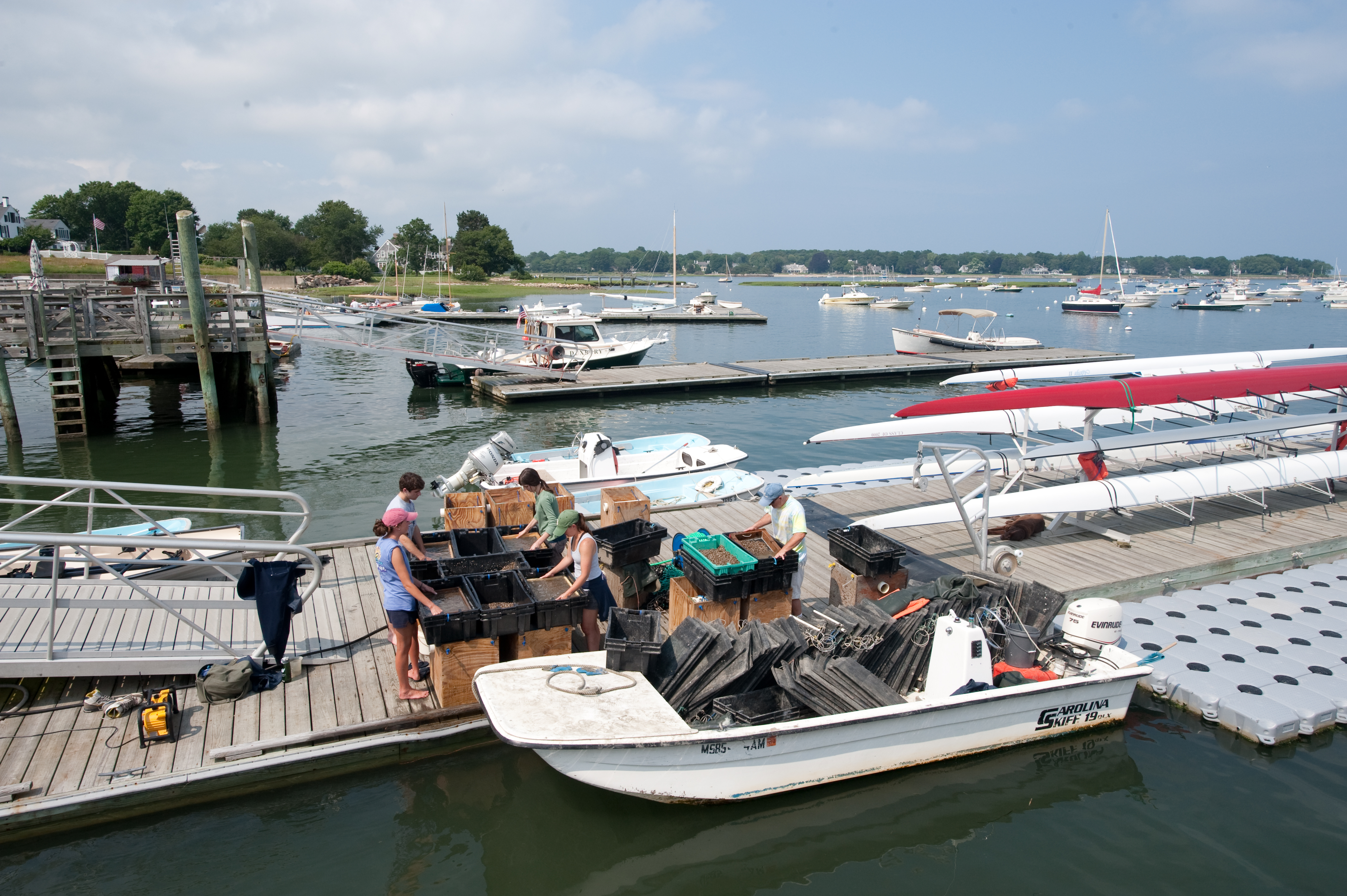 We're on a roll now, moving seed out from under ourselves daily. The weather and the tides have kept us from deploying a ton this week but between tomorrow and Friday, we'll have a huge chunk of seed out in the river and in our cages in the middle of the bay. We have to wait until low tide to get most of it out and the tides aren't cooperating like they should. They come in and out at varying speeds and this week, it's just been fickle. But at least Catie and I are past the hump of grading daily. Now we're giving our sub quarters a few days to pick up speed and grow.
We're on a roll now, moving seed out from under ourselves daily. The weather and the tides have kept us from deploying a ton this week but between tomorrow and Friday, we'll have a huge chunk of seed out in the river and in our cages in the middle of the bay. We have to wait until low tide to get most of it out and the tides aren't cooperating like they should. They come in and out at varying speeds and this week, it's just been fickle. But at least Catie and I are past the hump of grading daily. Now we're giving our sub quarters a few days to pick up speed and grow. 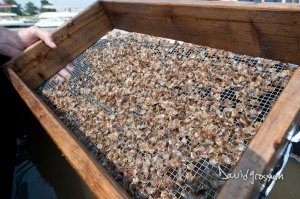
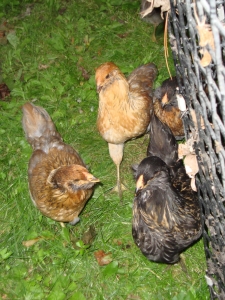
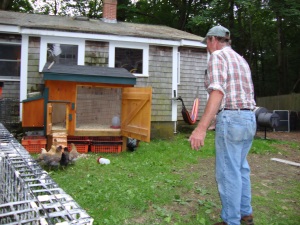
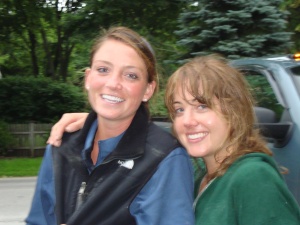
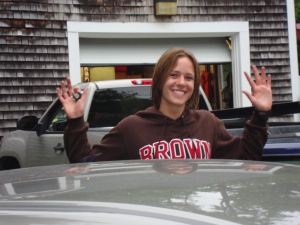
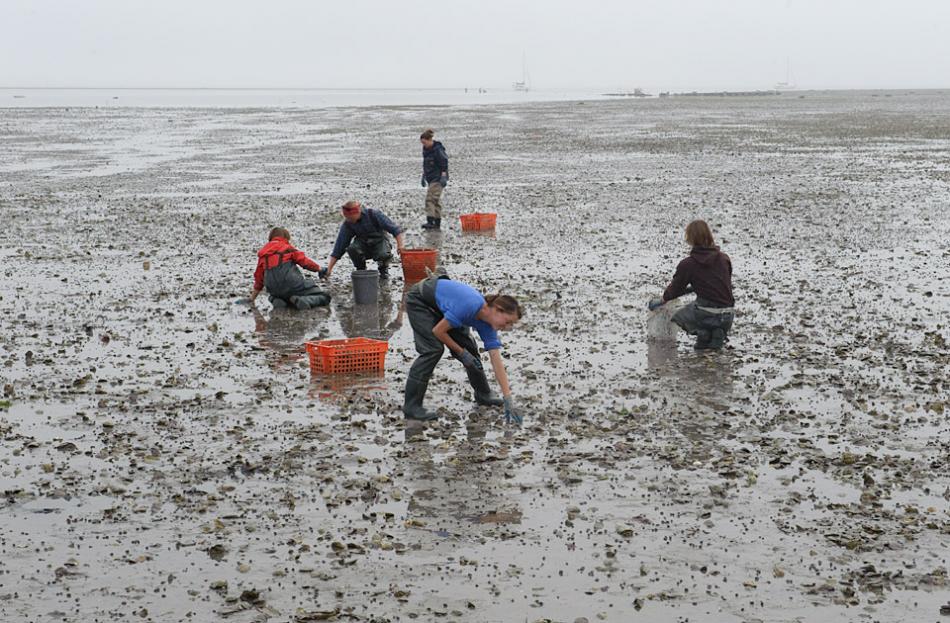 Phew. That was a long one. We just wrapped up a full week of drainer tides -- where low tide completely drains the bay floor giving us loads of time to hand pick oysters -- most of which started super early in the morning. It's typically the longest week of the year since the tide stays out for hours on end several days in a row. Only, we couldn't go out to pick on Monday or Tuesday because of the weather. Monday's storm seemed to hold on forever with the wind and rain blowing us off the float by lunchtime. Tuesday was another windy, rainy one. Catie and I were on the dock with the rain blowing at us sideways while we graded some of our seed. But it had to be done: our oldest seed had popped and almost a quarter of it was big enough to go into seed bags. When we grade, we separate the quarter-inch seed from the smaller stuff and put the smaller stuff back into the upwellers to continue growing. It brings down the volume in our silos allowing the smaller seed more room to grow. So we graded that batch and had enough quarter-inch seed to fill about 600 bags. At the end of the day on Tuesday, the crew spent the evening filling the bags with the seed and finally, on Wednesday morning (5:30 a.m. start time), we were able to get out on the tide. We spent the first few hours hand picking oysters and once the tide started to flow back in, we put the filled seed bags into cages which we set up in southeastern facing rows of 10 on part of the lease. Each cage hold 6 bags so we filled about 100 cages that morning. Quick work to do when the tide starts coming in but we got all the bags out and made it on the boat before the water spilled into our waders.
Phew. That was a long one. We just wrapped up a full week of drainer tides -- where low tide completely drains the bay floor giving us loads of time to hand pick oysters -- most of which started super early in the morning. It's typically the longest week of the year since the tide stays out for hours on end several days in a row. Only, we couldn't go out to pick on Monday or Tuesday because of the weather. Monday's storm seemed to hold on forever with the wind and rain blowing us off the float by lunchtime. Tuesday was another windy, rainy one. Catie and I were on the dock with the rain blowing at us sideways while we graded some of our seed. But it had to be done: our oldest seed had popped and almost a quarter of it was big enough to go into seed bags. When we grade, we separate the quarter-inch seed from the smaller stuff and put the smaller stuff back into the upwellers to continue growing. It brings down the volume in our silos allowing the smaller seed more room to grow. So we graded that batch and had enough quarter-inch seed to fill about 600 bags. At the end of the day on Tuesday, the crew spent the evening filling the bags with the seed and finally, on Wednesday morning (5:30 a.m. start time), we were able to get out on the tide. We spent the first few hours hand picking oysters and once the tide started to flow back in, we put the filled seed bags into cages which we set up in southeastern facing rows of 10 on part of the lease. Each cage hold 6 bags so we filled about 100 cages that morning. Quick work to do when the tide starts coming in but we got all the bags out and made it on the boat before the water spilled into our waders. 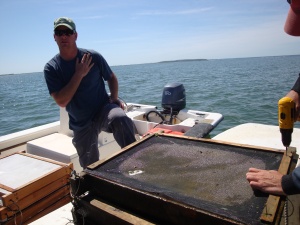
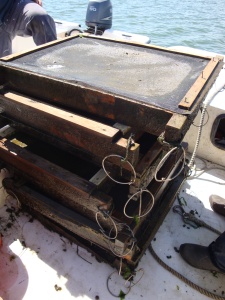
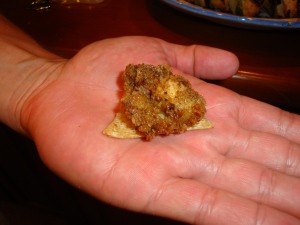
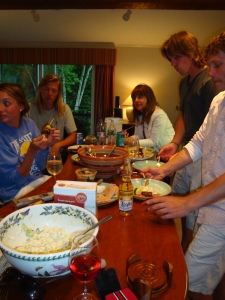
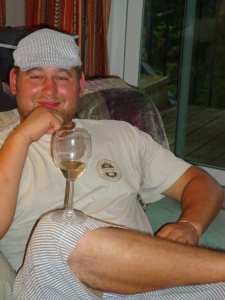
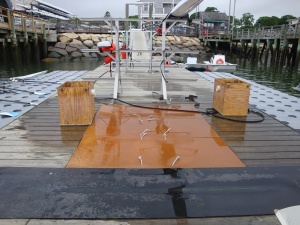
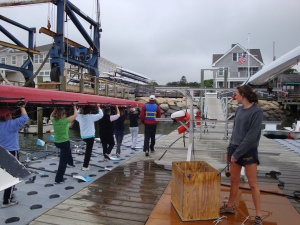
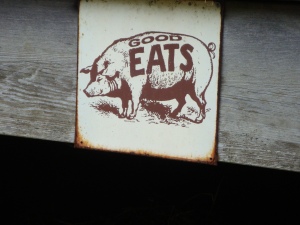
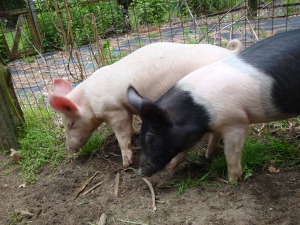
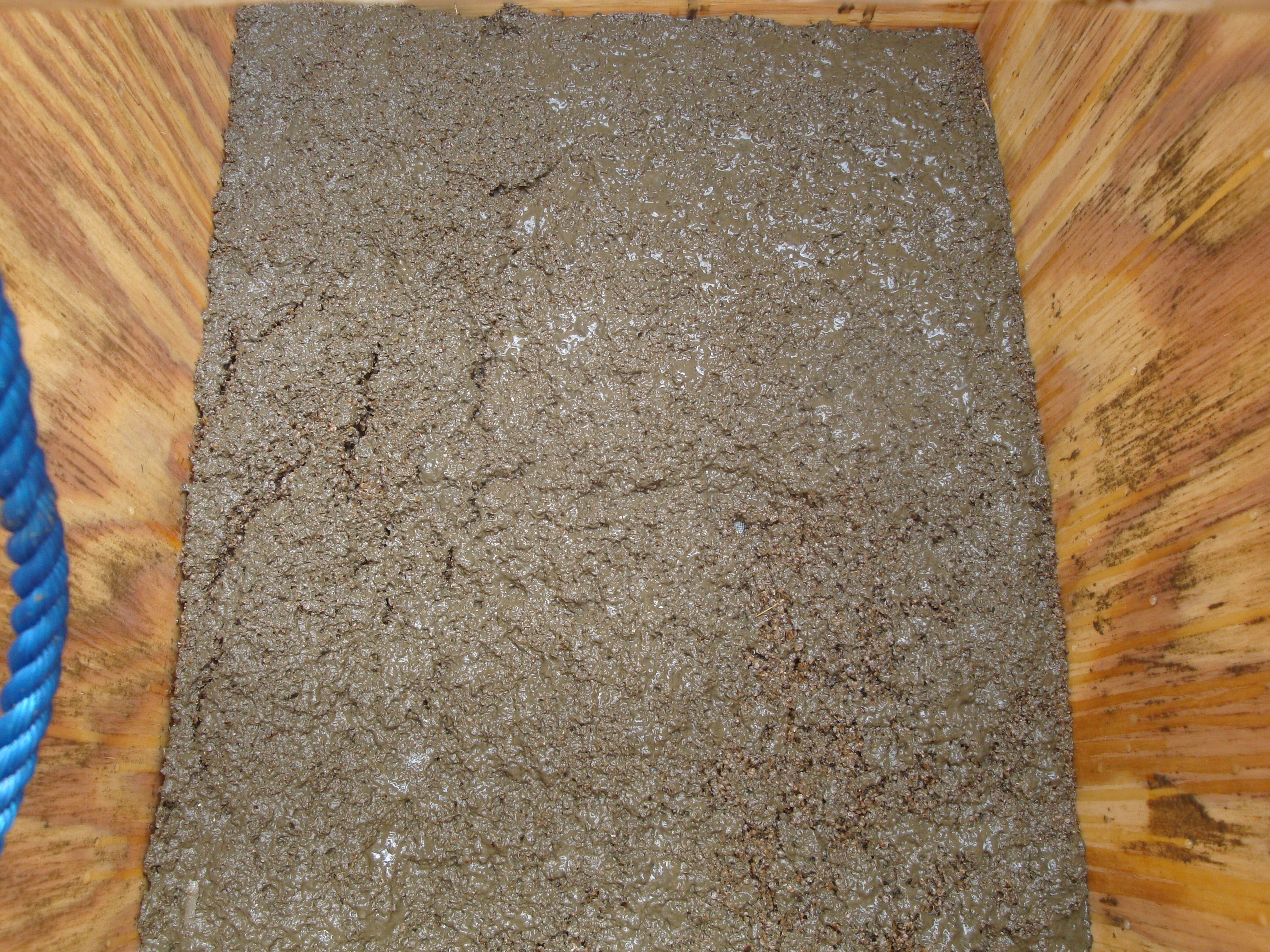

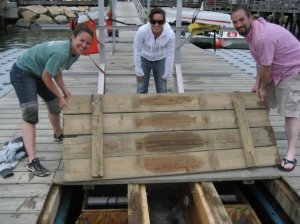
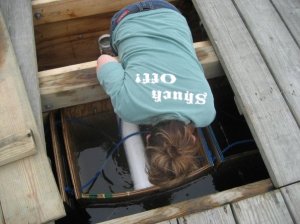
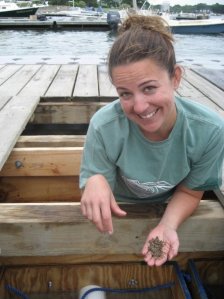
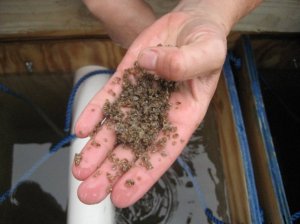
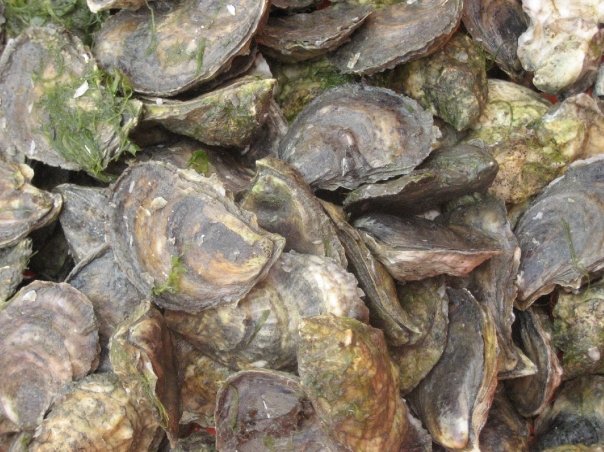
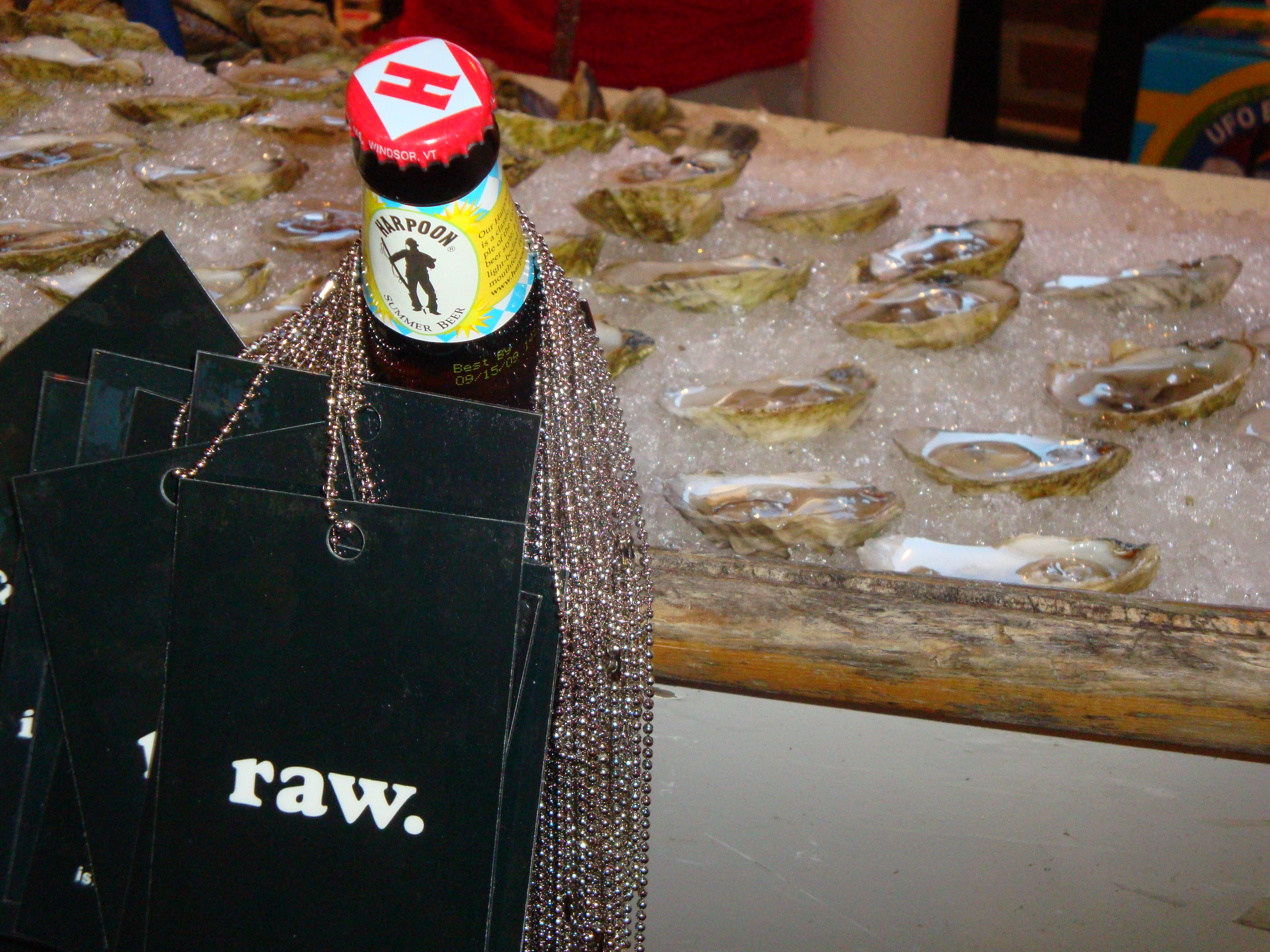
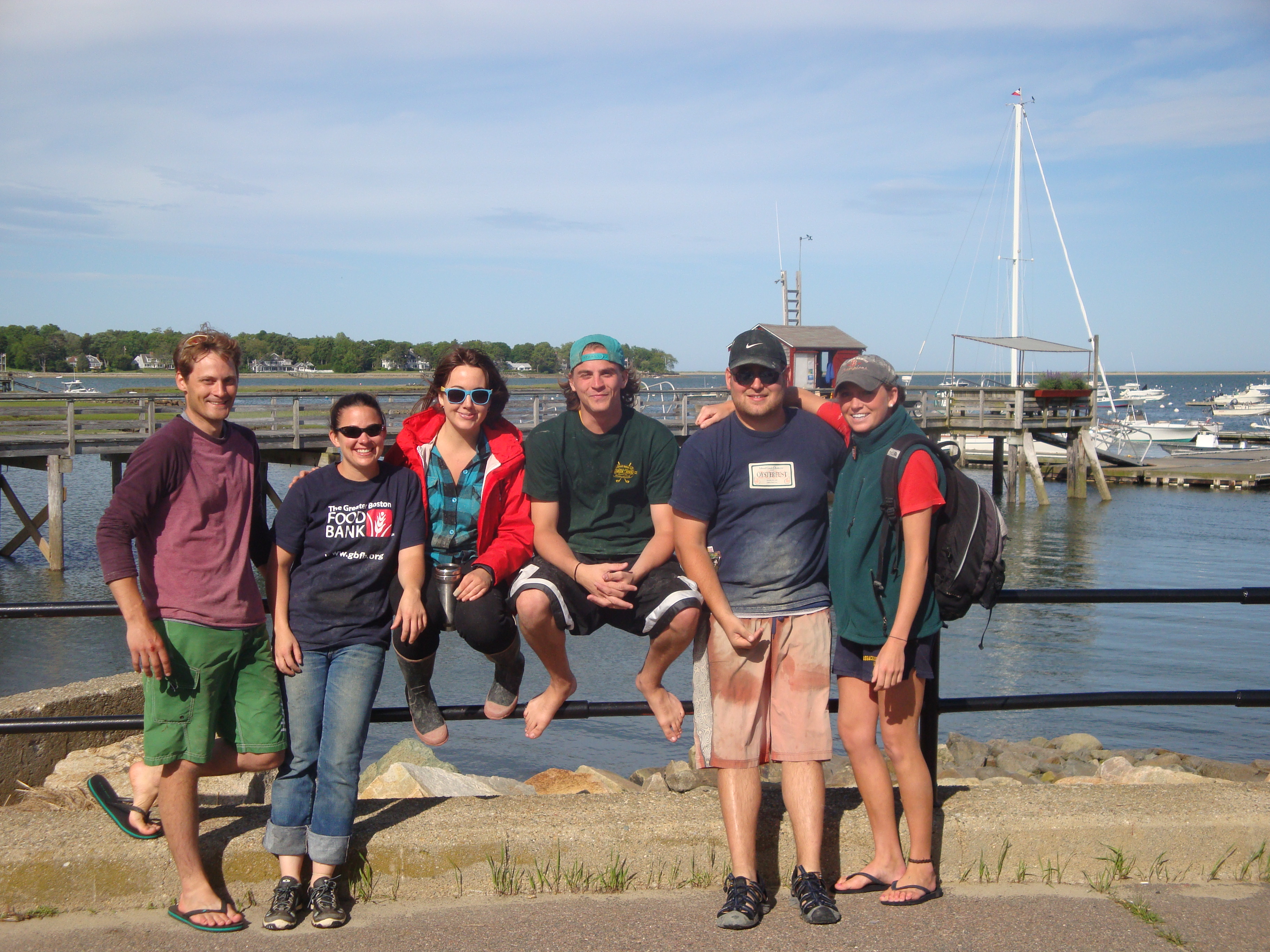 More new faces on the farm this week. Well, new to me anyway. Catie, a veteran on Skip's summer crew, started with us on Friday (she just graduated from Colgate) and Eva (fresh outta Brown) starts with us tomorrow. With all these extra hands, the work flies and we can go through a massive number of oysters in a day. We put in a full day today and logged more than 150 bags. Sheesh! Back when A2 and I were the only ones culling, we'd be lucky to hit 50 in a day (but we still had a damn good time doing it). We've come a long way -- more ridiculous humor (Will's "Dopeass quote of the day" can lay the entire crew out with laughter - Maggie and I were to the point of tears twice today), more opinions on what music we listen to (Maggie's a Kanye fan, which makes A2 happy; Will and I are into the classic rock/90s stuff; Quinn seems to like whatever's on) and more competitors in our ongoing 'name that tune' game. (1 point for the artist, 1 point for the song title. Berg is a champ with classic rock; A2 can list the entire Jam'n 94.5 playlist which repeats itself about 3 times a day.)
More new faces on the farm this week. Well, new to me anyway. Catie, a veteran on Skip's summer crew, started with us on Friday (she just graduated from Colgate) and Eva (fresh outta Brown) starts with us tomorrow. With all these extra hands, the work flies and we can go through a massive number of oysters in a day. We put in a full day today and logged more than 150 bags. Sheesh! Back when A2 and I were the only ones culling, we'd be lucky to hit 50 in a day (but we still had a damn good time doing it). We've come a long way -- more ridiculous humor (Will's "Dopeass quote of the day" can lay the entire crew out with laughter - Maggie and I were to the point of tears twice today), more opinions on what music we listen to (Maggie's a Kanye fan, which makes A2 happy; Will and I are into the classic rock/90s stuff; Quinn seems to like whatever's on) and more competitors in our ongoing 'name that tune' game. (1 point for the artist, 1 point for the song title. Berg is a champ with classic rock; A2 can list the entire Jam'n 94.5 playlist which repeats itself about 3 times a day.)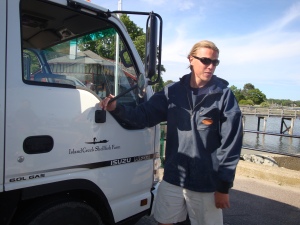
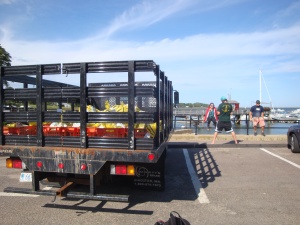
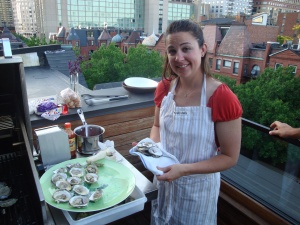
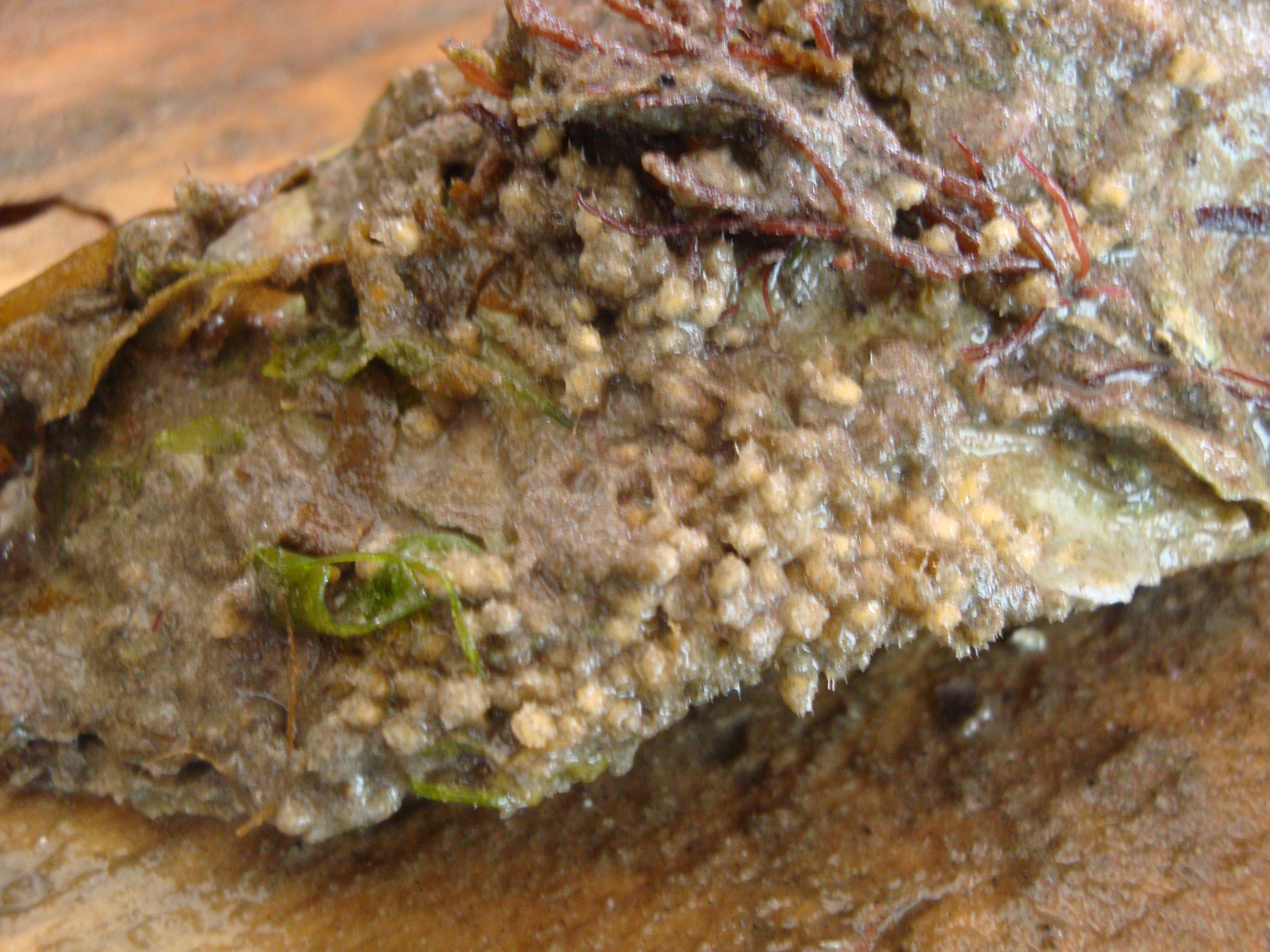
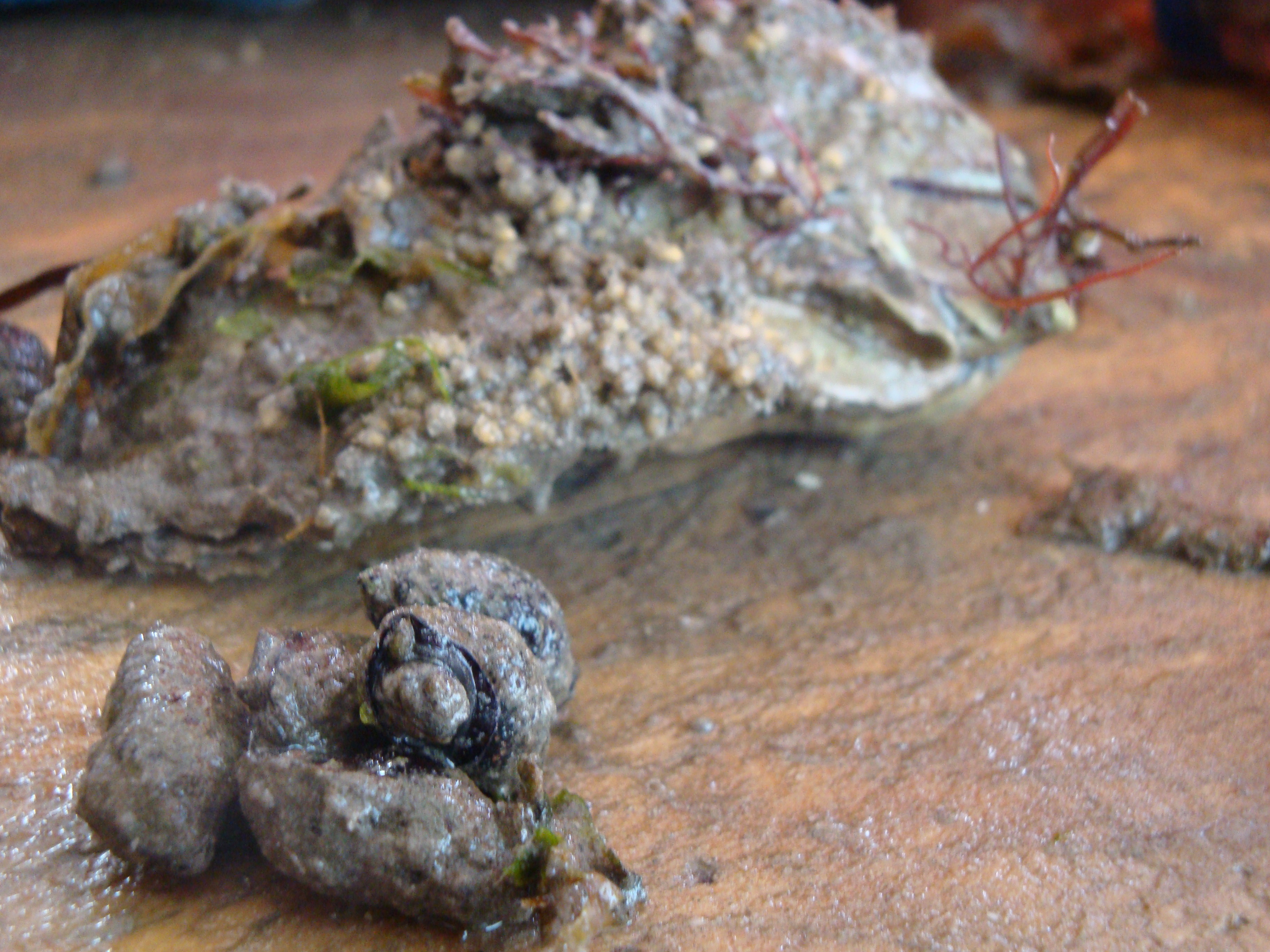
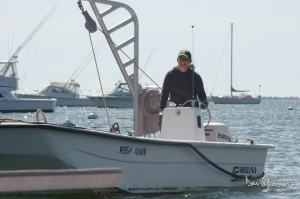 On Tuesday, I was out on the float and got a call from Skip asking me to drive the boat over to the dock (by myself - ack) to check out the upwellers. I made it over there without knocking into anything and found Skip,
On Tuesday, I was out on the float and got a call from Skip asking me to drive the boat over to the dock (by myself - ack) to check out the upwellers. I made it over there without knocking into anything and found Skip, 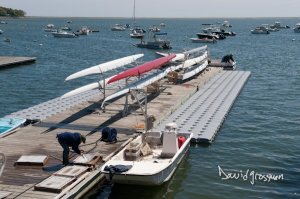
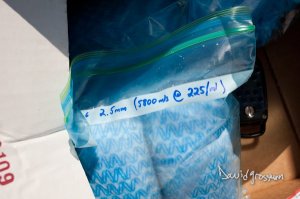
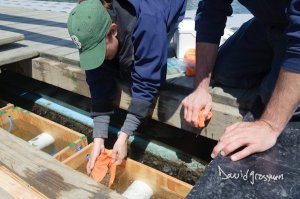
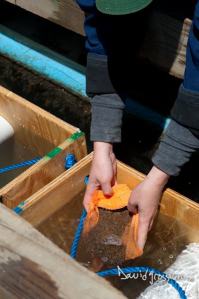

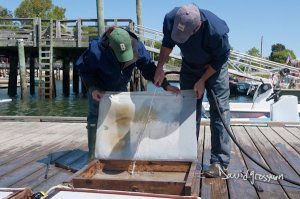
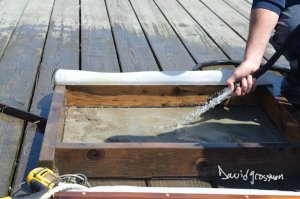
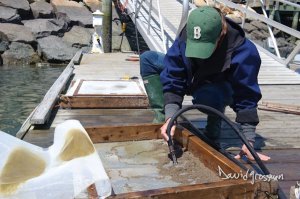
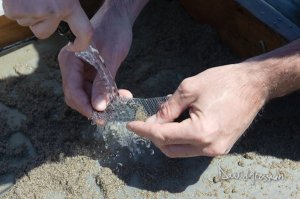
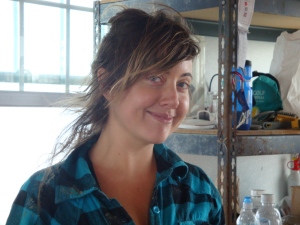

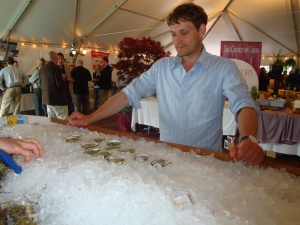
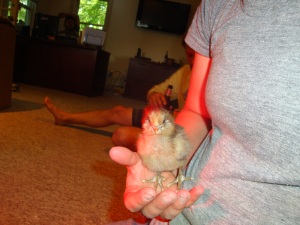
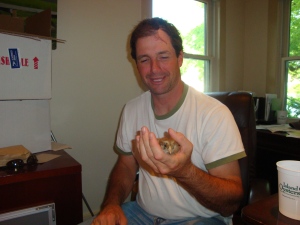
 There are far too many fun stories to tell about this past weekend. Not sure this little blog will do it all justice. But here goes.
There are far too many fun stories to tell about this past weekend. Not sure this little blog will do it all justice. But here goes. 











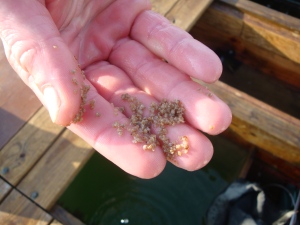 It is officially go time. The last few days have totally changed the dynamic at the farm. There's seed arriving daily and the growers are pumped. I got to the farm yesterday and found Mike George laying face down on the dock -- he was messing with the silo in his upweller which already has tons of little seedlings in place. It's tricky this time of year since the wind is still blowing hard east and can easily pick up and carry the seed out of your hand. But he was happy to show off his new babies.
It is officially go time. The last few days have totally changed the dynamic at the farm. There's seed arriving daily and the growers are pumped. I got to the farm yesterday and found Mike George laying face down on the dock -- he was messing with the silo in his upweller which already has tons of little seedlings in place. It's tricky this time of year since the wind is still blowing hard east and can easily pick up and carry the seed out of your hand. But he was happy to show off his new babies.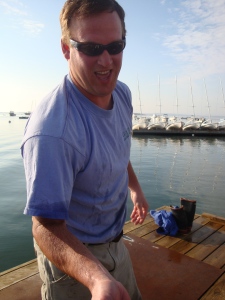
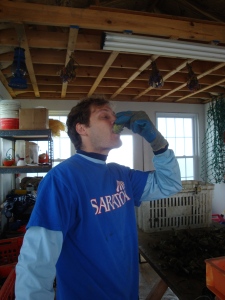
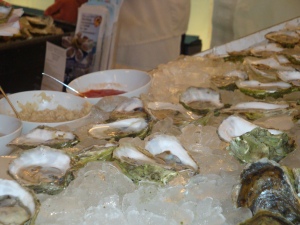 On Sunday, Island Creek participated in the first annual patio opening party at
On Sunday, Island Creek participated in the first annual patio opening party at 